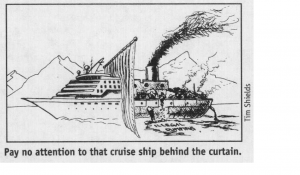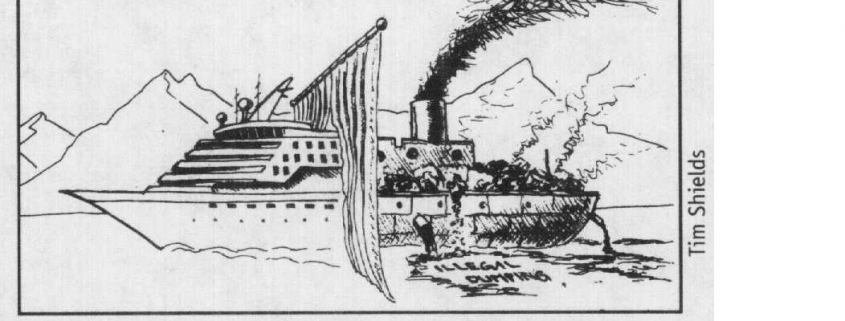Cruise Ship Pollution
by Dani Escontrela, RJD Intern
On a regular basis I am at Port Everglades which is one of the biggest cruise ships ports in the world and on any given day can house six or seven cruise ships, if not more. Every Saturday and Sunday the Oasis of the Seas and the Allure of the Seas are there, which are the biggest cruise ships in the world. These floating cities are extraordinary, everything needed to survive is on there and it functions just like any other city. They can even carry thousands of people at a time. I’ve been on cruise ships before and it feels like magic; everything is taken care off and at times it doesn’t feel like you’re out at sea. Cruise ships provide an important source of income through tourism not only to those working on the ships but to the ports of call that are visited (Cohen 2002); however, something we don’t think about the damage that cruise ships can cause. These ships can be a major source of waste and many times different cruise lines have been found guilty of illegally disposing of their waste. In fact some cruise lines like Regency Cruises, Celebrity Cruises, Princess Cruises, the Holland America line, and Royal Caribbean, among others, have been convicted in the past of illegally dumping oil, garbage, paint, plastic, ballast water and food waste into the waters of Alaska and the Caribbean (Cohen 2002). These acts have either been due to negligence, by accident or have been willful acts (Cohen 2002).

A cartoon of a cruise ship with a “double side”. On the front of the ship is what everyone sees; on the back of the ships is everything most people fail to see, including a lot of the pollution that results from cruise ships.
The dumping of waste by cruise ships can be harmful not only to wildlife, but also to humans as we are very closely connected to the resources in our oceans. However the control of dumping isn’t so straightforward. An international solution is needed in order to solve this problem. Two major agreements that address pollution by cruise ships have been set forth: the United Nations Convention on the Law of the Sea (UNCLOS) and the International Convention for the Prevention of Pollution from Cruise Ships (MARPOL). (Schulkin 2002)
UNCLOS has three significant sets of provisions for cruise ship pollution: “First, it creates standards for registering ships. Second, UNCLOS sets limits on national jurisdiction over seas. Third, the convention provides guidelines for restricting marine pollution and for enforcing violations of pollution regulations”. UNCLOS divides the sea into different zones, and under each zone there are different enforcement powers. However, often times the provisions set forth by UNCLOS don’t have effective means of enforcement. Under the convention, States have the responsibility of protecting and preserving the marine environment in their Territorial Sea (which extends 12 nautical miles out from their low water mark). They have to create laws and regulations to prevent pollution from their ships. However many states have yet to come up with their own set of laws. (Schulkin 2002) In fact Alaska is the only state in the US that has taken any initiative to make its own laws. In 2001 Alaska pushed for Title XIV of the Labor, Health and Human Services Appropriations Bill after a fleet of 22 ships failed tests for their sewage treatment. While the federal limit for fecal coliform bacteria is 200 bacteria per 100 milliliters of sample, tests revealed bacteria in the excess of millions per sample. Title XIV “requires the coast guard to develop monitoring and reporting programs… authorizes the EPA to develop effluent limits for all waste streams, allows Alaska to petition the EPA to establish no discharge zones” and perhaps most importantly “allows Alaska to pass any other laws or regulations necessary to control the industry’s pollution-related activities in state waters.” (Cohen 2002). This has been a crucial step for Alaska and this state may be serving as a model for others. In fact states like California and Florida are already considering similar bills.
MARPOL was an agreement that was enacted in 1983 and sets many of the standards for vessel pollution referenced in UNCLOS. It consists of the main protocol in addition to five annexes specific to the different types of pollutions. The main protocol “contains provisions for prosecuting violations of the pollution standards found in the annexes”. The states are the main players in enforcing the rules and standards and prosecuting any violators. Annex I regulates the discharge and transport of oil, Annex II sets standards for ships carrying hazardous liquid in bulk (this Annex doesn’t apply to cruise ships since they don’t carry it in sufficient quantities), Annex III regulates the transport of packaged hazardous substances, Annex IV provides standards for sewage treatment and discharge, and Annex V regulates the disposal of garbage at sea. However, neither Annex II nor III set standards for treating and discharging hazardous waste at sea and Annex IV and V have not received enough signatures for them to enter into force. While MARPOL has done a significant job in reducing cruise ship pollution, the convention still contains gaps and enforcement is sometimes sporadic. (Schulkin 2002)
Other problems that need to be addressed by countries and/or states is the disposal of garbage the ports. Many ships pay for proper disposal of their waste material at the ports; however, many times officers have observed improper disposing of wastes (Townend 2010).
The cruise ship industry has been growing and continues to grow at a significant pace; in fact from 2009 to 2010 a 9% growth was recorded (Townend 2010). With cruise ships like the Allure of the Seas, which can carry 8420 people, a lot of waste is generated; with the prospect of bigger ships to come out in the future, pollution is a problem that needs to be addressed soon. We can’t expect for cruise ships to stop running as they can actually be of great help by providing tourism to areas that might otherwise have not been visited. In order for the benefits to prevail, changes in the maritime industry need to be made that more effectively address cruise ship pollution. It has been reported that many cruise ships have improved their waste management, which is a good step. All cruise ships must now have a garbage management plan and a ‘garbage record book’ which records all disposal and incineration operations. (Townend 2010) Although these protocols have been put into place it is now up to the cruise ships to follow them and up to the countries and states to penalize anyone that doesn’t.
Although significant improvements remain to be made, we have come a long way. As Schulkin states at the end of his paper “Cruise ship pollution is a global problem that requires a global solution”.
REFERENCES
Cohen, Gershon. “Cruise Ships Fail Pollution Tests.” Earth Island Journal 16.2 (2002): 7. Print.
Schulkin, Andrew. “Safe harbors: Crafting an international solution to cruise ship pollution.” Georgetown International Environmental Law Review 15.1 (2002): 105-32. Print.
Townend, William K. “Marine Pollution.” Waste Management & Research 28.11 (2010): 959-60. Print.




Leave a Reply
Want to join the discussion?Feel free to contribute!